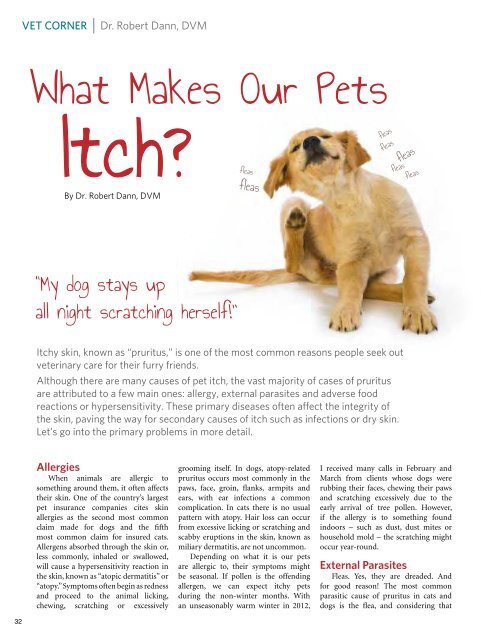DAVID DUFFIELD - PAWS Chicago
DAVID DUFFIELD - PAWS Chicago
DAVID DUFFIELD - PAWS Chicago
Create successful ePaper yourself
Turn your PDF publications into a flip-book with our unique Google optimized e-Paper software.
VET CORNER<br />
Dr. Robert Dann, DVM<br />
What Makes Our Pets<br />
Itch<br />
By Dr. Robert Dann, DVM<br />
“My dog stays up<br />
all night scratching herself!”<br />
Itchy skin, known as “pruritus,” is one of the most common reasons people seek out<br />
veterinary care for their furry friends.<br />
Although there are many causes of pet itch, the vast majority of cases of pruritus<br />
are attributed to a few main ones: allergy, external parasites and adverse food<br />
reactions or hypersensitivity. These primary diseases often affect the integrity of<br />
the skin, paving the way for secondary causes of itch such as infections or dry skin.<br />
Let’s go into the primary problems in more detail.<br />
Allergies<br />
When animals are allergic to<br />
something around them, it often affects<br />
their skin. One of the country’s largest<br />
pet insurance companies cites skin<br />
allergies as the second most common<br />
claim made for dogs and the fifth<br />
most common claim for insured cats.<br />
Allergens absorbed through the skin or,<br />
less commonly, inhaled or swallowed,<br />
will cause a hypersensitivity reaction in<br />
the skin, known as “atopic dermatitis” or<br />
“atopy.” Symptoms often begin as redness<br />
and proceed to the animal licking,<br />
chewing, scratching or excessively<br />
fleas<br />
fleas<br />
grooming itself. In dogs, atopy-related<br />
pruritus occurs most commonly in the<br />
paws, face, groin, flanks, armpits and<br />
ears, with ear infections a common<br />
complication. In cats there is no usual<br />
pattern with atopy. Hair loss can occur<br />
from excessive licking or scratching and<br />
scabby eruptions in the skin, known as<br />
miliary dermatitis, are not uncommon.<br />
Depending on what it is our pets<br />
are allergic to, their symptoms might<br />
be seasonal. If pollen is the offending<br />
allergen, we can expect itchy pets<br />
during the non-winter months. With<br />
an unseasonably warm winter in 2012,<br />
fleas<br />
fleas<br />
fleas<br />
fleas<br />
fleas<br />
I received many calls in February and<br />
March from clients whose dogs were<br />
rubbing their faces, chewing their paws<br />
and scratching excessively due to the<br />
early arrival of tree pollen. However,<br />
if the allergy is to something found<br />
indoors – such as dust, dust mites or<br />
household mold – the scratching might<br />
occur year-round.<br />
External Parasites<br />
Fleas. Yes, they are dreaded. And<br />
for good reason! The most common<br />
parasitic cause of pruritus in cats and<br />
dogs is the flea, and considering that<br />
“My cat has<br />
licked himself<br />
raw.”<br />
one insect can bite hundreds of times<br />
in a day, a single flea has the potential to<br />
wreak havoc on your pet’s skin.<br />
When a flea bites, its saliva is injected<br />
into an animal’s skin where a protein in<br />
the saliva can act as a potent allergen. A<br />
flea-allergic pet can remain severely itchy<br />
for many days after a small number of flea<br />
bites, so all allergic pets need rigorous,<br />
continuous protection from flea bites.<br />
Ruling out the possible presence of fleas<br />
is paramount in any itchy pet.<br />
There is a simple test that can be<br />
performed at home to check for evidence<br />
of fleas. With a pet in a sitting position<br />
in the bathtub or on a table or counter,<br />
vigorously rub the lower back and tail<br />
base area up and down with your fingers.<br />
If a pet has fleas, there probably will<br />
be flea droppings in these areas. When<br />
rubbed, these droppings (essentially<br />
little specks of flea-digested blood from<br />
your pet) will fall to the surface. Take a<br />
flat, moistened paper towel and holding<br />
it by two corners, pull it over the surface<br />
where your pet had been sitting. The<br />
flea droppings will appear as little black<br />
specks that smear out bloody on the wet<br />
paper towel.<br />
Mildly infested pets are pretty easy<br />
to treat, but with heavy infestations, the<br />
pet and its environment must be treated.<br />
Other parasitic causes of pruritus in<br />
pets, much less common than fleas, are<br />
various forms of arthropods known<br />
as mange mites, lice or chiggers. Your<br />
veterinarian will be able to identify these<br />
parasites with a few simple tests and a<br />
microscope.<br />
Food Hypersensitivity<br />
Food hypersensitivity is a nonseasonal<br />
allergic reaction to food or<br />
additives in the diet. It can occur in pets<br />
at any age, including very young pets<br />
food<br />
allergy<br />
and elderly pets that have consumed the<br />
same diet for many years. In cats there is<br />
no classic pattern of lesions, but pruritus<br />
abounds. Redness, hair loss, scabs and<br />
crusts may be seen on the torso and<br />
limbs, or may be confined to the head<br />
and neck areas. In dogs, pruritus can<br />
occur anywhere, including the ears and<br />
rear end.<br />
Continued on page 34<br />
Therapy<br />
The best source of information for<br />
diagnosing and treating your itchy pet will<br />
be your veterinarian. Once a diagnosis of the<br />
etiology of pruritus is made, therapies to bring<br />
it under control can be prescribed. Many<br />
classes of medications, both systemic and<br />
topical, can effectively treat allergy. Avoidance<br />
of the allergen is the treatment of choice if<br />
possible, such as with food or flea bite allergy.<br />
Allergy vaccine (as injection or more recently<br />
by mouth) is the only treatment that may<br />
alter the course of pets with atopic dermatitis.<br />
To keep pets comfortable, symptomatic<br />
treatments can be used which range from<br />
mild (antihistamines, medicated baths) to<br />
aggressive (corticosteroids and the drug<br />
cyclosporine), with the latter having greater<br />
risk for side effects. When parasites are the<br />
cause of itch, they can be targeted with very<br />
specific products readily available for each<br />
particular parasite.<br />
An itchy pet can be frustrating to treat,<br />
but the vast majority can be managed very<br />
successfully, restoring their comfort and<br />
quality of life. And yours!<br />
32
















